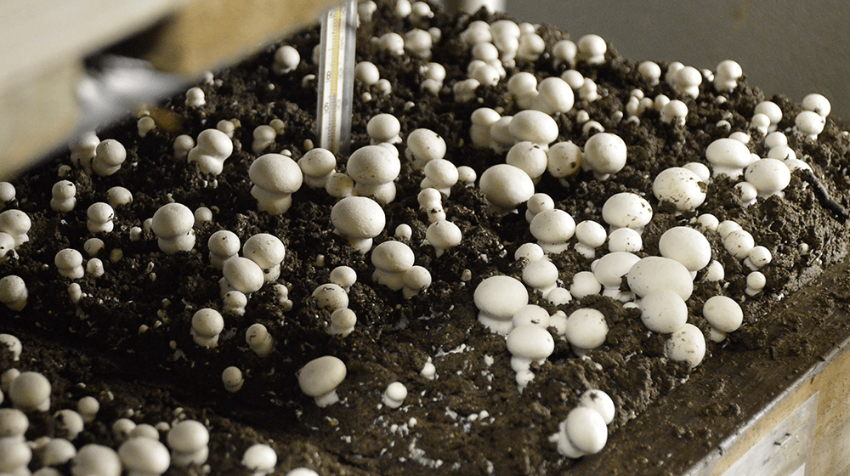Mushroom farming, which started many years ago, today is one of the most rapidly growing farming businesses. As a business, the predicted growth rate is 10% over the next 5 years. And the US is the world’s second-largest producer.
What is a Mushroom Farm?
Mushrooms are fungi, that grow and live in organic material. Growing mushrooms is also called fungi culture. The business of growing them is a mushroom farm.
Why You Should Start a Large-Scale Mushroom Farming Business
Do you want to start a large-scale mushroom farm because you’re a fun-gi?
There’s are other good reasons:
- Mushrooms can be grown year-round.
- Mushrooms are grown indoors, so not directly impacted by weather as is a typical problem in farming.
- Waste can be recycled.
- High-protein foods are in demand and mushrooms are high protein.
- With a good business plan for expansion, you can start small and grow.
- Empty industrial buildings have the potential for growing mushrooms in urban farming settings.
The Mushroom Farm Industry in the United States
In 2020, the mushroom farm industry was valued at about $46 billion. The compound annual growth rate is projected at 9.5% from 2021-2028.
Harvested mushrooms have a short shelf life, from 1-3 days. That may be why the highest growth rate is predicted to be in mushroom processed forms, such as dried, frozen, canned, pickled and powdered.
The US is the world’s second-largest producer and Europe is the world’s biggest consumer. Europe relies almost entirely on imports to supply that food.
How Much Does it Cost to Start a Mushroom Farm?
The cost to start mushroom growing of course can vary widely, depending on how big the operation is at the outset. The cost can range from $3,000 to $100,000. In the farm industry, that’s low amongst starter crops.
The main cost is acquiring the right space – You need a building with a concrete floor where you can supply adequate ventilation and temperature control. You’ll also need plenty of outdoor space, preferably with a concrete floor.
Here’s an example: With a 500-square-foot growing space, you should produce 12,000 pounds of mushrooms a year. A pound of mushrooms is currently sold at $6-8 per pound.
How long before you’re flush? Business income in the first year of mushroom growing can be $120,000. By the third year, the profits should double your business income.
Products that Can be Sold by a Mushroom Farming Business
Post-crop mushroom compost – Can’t be reused by the mushroom grower, but is valuable as a soil amendment or potting dirt.
Ready-to-fruit blocks – These blocks are kits usually containing sawdust and grain, compressed into a block. The grain is inoculated with mushroom spawn. The blocks are each put in a plastic bag and put in a box. The blocks are sold to consumers as kits, for $20 and more depending on the variety on the block.
Mushrooms – Shiitake is the most profitable type, currently at $12 per pound. Oyster mushrooms are gourmet, and also widely popular. Up and coming is Maitake, also known as Hen of the Woods. It’s so named because it has a slight chicken taste, and is popular with cooks and chefs.
How to Start a Mushroom Business: 11 Important Steps
You’ve already learned that you need space, air/light and temperature control. The size and proper maintenance of the compost pile are of utmost importance for success.
This can involve work that is extremely labor-intensive. For example, the pile can be turned by a piece of equipment, such as a tractor with a bucket. The compost pile needs aeration. Large-scale growers use forced air – delivered by nozzles or spigots – or specialized compost turning machines.
In other words, step 1 in the business is very careful planning.
Step 1: Start Planning Your Business
Start with a list of basic needs for the business of growing mushrooms:
- You need plenty of space, indoors and outdoors.
- You need an indoor facility where it’s not overly costly to provide ventilation and temperature control and light. As a rule, you’ll need a room where temperature, light and ventilation can be controlled.
- You need access to nearby markets.
- You need an odor reduction plan for compost that is on deck outside.
- Proximity to agricultural areas is a plus, as you’ll need access to supplies such as horse manure.
Step 2 – Acquire the Land
A typical compost pile is six feet wide, six feet high, and as long as necessary. If moisture is added to the pile – such as with rain or snow – that can compact the content, and that’s bad.
Compaction can cause all sorts of problems. Growth becomes anaerobic and provides perfect conditions for viral, bacterial and fungal diseases.
In short, Step 2 is the most important step. Here’s the perfect property:
- Concrete floors outdoors that are covered by roofing.
- An indoor room that already has ventilation to control humidity and temperature. The best is hot air blown through ventilation ducts.
- Outdoor areas large enough for compost piles. Consider proximity to residential areas, as due to content the compost piles can emanate odors. Outdoor compost piles must be covered to prevent rain/snow from affecting them.
Step 3: Learn Everything You Can about Mushroom Farming
There are some basic terms to know about growing mushrooms:
- Spores – Who knew? Mushrooms produce millions of microscopic spores. The spores are on the gills which line the underside of the cap. The spores are like seeds.
- Spawn making – Getting spores to germinate is called spawn making. The prepared spores are called Mycelium.
- Spawn – The Mycelium plus water are added to sterilized grain, such as millet, rye or wheat. Rye grain is most commonly used. It is then called spawn. Spawn can be refrigerated for a few months.
Many colleges and universities provide a guide for starting a mushroom business.
Step 4: Decide How Your Mushroom Farm will be Designed
Step 4 is design. There are three main growing systems for mushrooms, and each has two phases.
In phase one, the compost is prepped. this takes place in the open air but under a roof. In phase two, the compost is kept in the right condition for growing.
Here are the main production designs:
- Zoned – The compost is packed about 6 feet high onto trays. The trays are moved to an environmentally controlled room.
- Bed or shelf – One room is used for all stages.
- Bulk system – Compost is placed in an insulated tunnel. The tunnel has a perforated floor and computer-controlled aeration. When it’s prepped it’s moved to an environmentally controlled room.
Step 5:Acquire the Materials and Equipment
Step 5 is material and equipment. The basic materials for compost content are horse manure and wheat straw.
And P.S. the horse farm probably isn’t going to deliver. You’ll need a dump truck.
Due to the seasonal nature of straw availability, you need to buy when available and store on your property.
Gypsum is added to the compost mix. Gypsum helps air permeate the compost. Usually, you’ll need 40 pounds of gypsum per ton of manure mix.
Mycelium – The starter spores for the mushrooms.
Peat Moss – This is added as a top layer to the compost once it’s set in place in the incubation room.
Supplements – Years ago, mushroom growers added nitrogen supplements such as peanuts, cotton and corn distillers grain to the compost. That’s still done as it was years ago. But today there are commercially-made supplements that are time-released.
Step 6: Decide Which Mushrooms You will Grow
The are three main varieties: smooth white, off-white, and brown. There are eight strains in each variety.
How do you choose? What’s your market?
Shiitake has many benefits for growers. The biggest benefit is that it’s the species most commonly used in its dry form.
Oyster mushrooms are considered a delicacy and much-sought by restaurants.
Crimini and Portobello are prized for their unique flavors. Also in demand by restaurants.
Step 7: Choose Your Cultivation Method
Prepping the compost is hugely important and more technical than you’d think.
The mix – Typically the compost mix is about 85% manure and straw, plus the other ingredients such as gypsum.
The equipment – As a basic, you’ll need a loader (with a bucket). The compost should be turned over, 3 or 4 turns for a section, every 2 or 3 days. The main thing to avoid is compaction. A large-scale business uses a compost turner, that mixes and aerates. That doesn’t replace the loader. You’ll need a loader to move the material to the compost turner.
Aeration technique – A compost turner can do the aerating. Or the compost can be aerated by a forced-air system that is piped into the compost area.
Temperature control: Prepping the compost takes 2 or 3 weeks. Then it is ready to be pasteurized in a temperature-controlled room. The temperature of the compost is lowered in stages in the room to kill bacteria and weed seeds, and remove ammonia. This process takes about a week.
Step 8: Hire a Team
Even when many of the steps are automated, such as temperature and moisture control, your farm manager is important. Temperature and moisture control must be constantly monitored, and quick adjustments made as needed.
At harvest time, you’ll need access to hard-working temporary workers.
Step 9: Get Your Mushroom Production Right
Let’s review. Here’s a checklist of steps in the mushroom business:
Produce or Buy the Spawn
The spores come from gills that are under the mushroom cap. Getting the spores to germinate is called spawn making. The prepared spores are called mycelium. Spawn is a grain or seed that holds mushroom mycelium.
The majority of large-scale farmers buy mushroom spawn. They choose that method because the mushroom spores germination can be unreliable.
Create and Prepare the Substrate
You’ll need to plan a way to have a steady acquisition of the main ingredients. Each ingredient is crucial to the proper preparation of the substrate, or compost base.
Incubate the Mushrooms
There are two steps, casing, and pinning, that take place in the fruiting room:
Casing – The compost is moved to the fruiting room. In that room, a layer of mixed peat moss and limestone is spread over it.
Pinning – The spawn is spread in the casing. When the first mushrooms appear, they look like very slender white pins. That’s why it’s called pinning.
Complete the Fruiting Process
The pins grow into buttons and then larger mushrooms in the fruiting room. They will be ready for harvest in 18-21 days.
Harvest at Full Mushroom Growth
Harvesting mushrooms is labor-intensive. The harvest time can stretch over 16 to 35 days. As workers pick and choose mature mushrooms, more are maturing.
Once the harvest has ended, the rooms must be emptied and sterilized by steam.
Step 10: Market Your Farm
Now you need to shed the light on your “underground” business. Mushrooms are in high demand as food products. What’s the best way to connect with that food demand for mushrooms?
- Network – Use social media to announce your first and successive mushroom crop. Use your website and also place a site on FB.
- Reach out to businesses likely to buy your mushrooms: restaurants, grocery stores, farmers markets and food co-ops.
- Find sources to sell less-than-perfect mushrooms. These can be dried or used as animal feed, especially chickens.
- Consider marketing “starter” blocks in bags as part of your mushroom farm business. Block bags are increasingly popular. That’s because the blocks not only provide fresh, tasty mushrooms. The blocks can also be educational for families.
Step 11: Have a Profitable Large-Scale Mushroom Business
Your first crop is in the books. Now what?
Keep close tabs on conditions in the grow room, using preventative maintenance to make sure proper humidity and temperature levels continue.
Constantly monitor your supply of raw materials. Lose one, and you’ll need a new way to make compost.
Things to Consider Before Starting a Mushroom Farm Business
One sure way to create negative publicity for your fledgling mushroom business is to have odor/nuisance complaints. Every guide for growing mushrooms lists odor control as highly important. You can be proactive about odor control by finding the right space.
For your site, choose a lot that is not close to residential areas. Choose a lot that has a concrete base, or a lob where you can add a concrete base. Make sure there are roofs over the compost.
Here are more considerations that are recommended as a guide:
Is There a Market for Mushrooms in Your Area?
Mushrooms have a limited shelf life of 3 to 5 days. You’ll need a ready market once harvest starts.
How Much Capital Do You Need for a Mushroom Farm?
You’ll need up to $100,000.
Do You Have the Right Type of Substrate for Your Mushroom Farm?
You’ll know by how it responds as it is developed during Phase 1 outside. If you’re seeing a lot of compaction during turning, for example, you need more dry material.
What kind of Competition do you Face?
There are 3 main types of mushrooms and 8 varieties within those types. If there’s a competitor already flooding the market with a certain type, you’ll want to find your niche with something different, such as marketing a mushroom block.
How will you Handle Contamination Control?
Contamination can happen at every stage, and it’s one of the biggest concerns. For example, one common way contamination happens is by infiltration of spores from nearby wild mushrooms.
Here are steps to take for prevention:
- Both phase one (outdoor) and phase 2 (indoor rooms) are important steps in prepping the compost. Keep both of the phases completely separate.
- Control worker practices. Workers should practice good personal hygiene and wear hair restraints. No food, beverages, gum or tobacco can be used in the workplace. Workers who are ill should not come to work.
- Water sanitation – the water should be monitored and tested.
How will you Manage Waste Control?
The used compost can be added to dirt to make a good growing medium. It can be recycled back into fields as part of bioremediation.
The Best Areas to Grow Mushrooms in the United States
Since the business involves lots of outdoor work, certain year-round climates are best.
Due to the constant need for raw materials, the proximity of rural farming communities is advised.
But! Take a look at Mycopolitan. In 2014 a group of friends began to grow mushrooms as a business in an empty auto parts factory in north Philadelphia. Their mushrooms are grown on blocks, blocks, and blocks of them, placed on shelving. It’s a mushroom farm in an untraditional space, that provides fresh mushrooms to a slew of area restaurants. This is just one agribusiness example with an innovative solution.
Is mushroom farming easy?
No. There are elements of it that seem simple, such as the shortlist of ingredients for the compost.
But at every step, the development and maintenance of the compost must be monitored and adjusted. You need the right setup to make that happen.
How much land is required for farming mushrooms?
If you plan to go large scale, you need to start with a property big enough for expansion.
Remember the example: 500 square feet of growing space can produce 12,000 pounds of mushrooms annually. But, that “growing space” is indoors, a room that’s 25 x 25 feet. And the outdoor space needed to produce the compost base will be larger.
How big do you want to go, how much indoor growing space will you need, and how much outdoor space to support that?
Experts advise a site with a minimum of three acres. You can start with vacant land or find a vacant industrial building that lends itself to the process.
How does a mushroom farm make money?
Mushroom farms make money by selling mushrooms. They also make money by selling used growing material.
Increasingly, selling a mushroom “starter kit” in block form is providing an additional profit. Cooks and families enjoy growing mushrooms using a block.
How much profit can a mushroom farm make?
A 500-square foot growing space should produce 12,000 pounds of mushrooms annually. The cost per pound of mushrooms can vary by type.
A mushroom starter kit as a block can be sold for $20 and more. The cost of a block depends on the type of mushroom.
Can I grow oyster or shiitake mushrooms in compost?
You need compost as a base, but you also need a top layer over that. Then you mix the spawn into that top layer.
Image: Depositphotos








